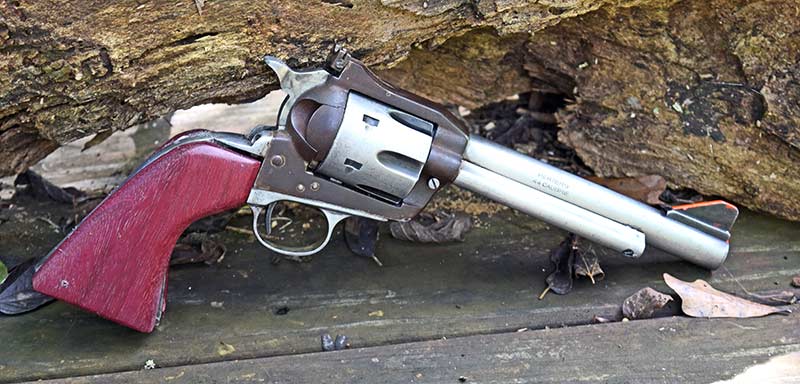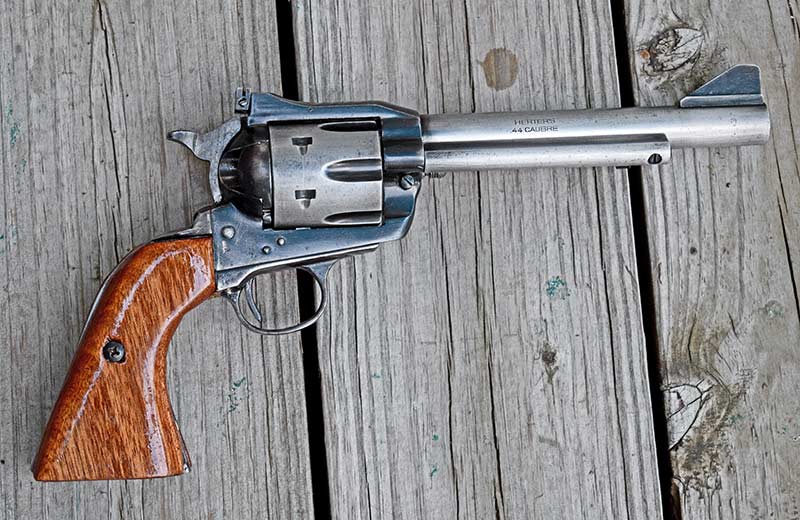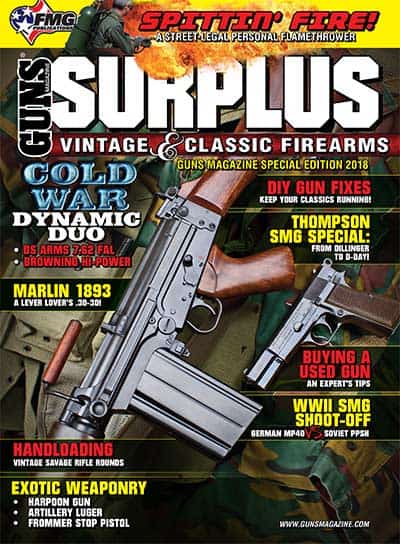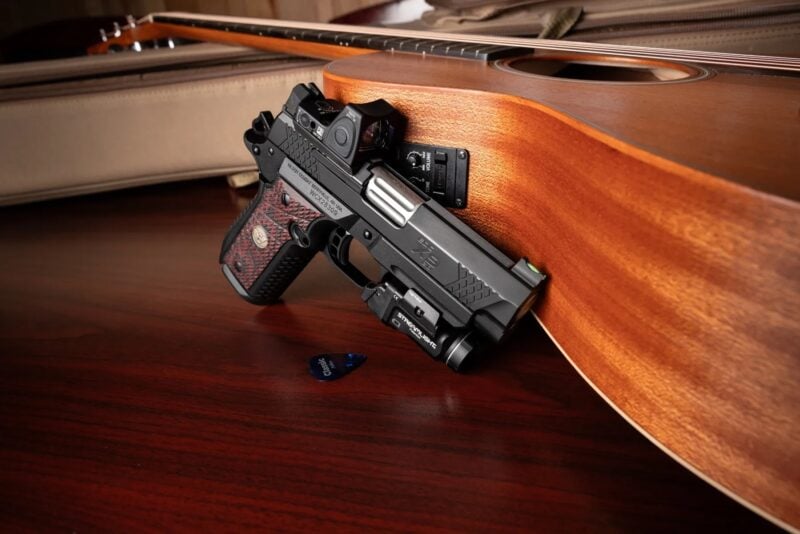Herter's Big Bore Sixguns
The “Other” Magnum Revolvers
Readers in my age group likely remember when the Herter’s Company had a thriving mail order sporting goods business, selling everything from firearms and ammunition, reloading equipment and fishing tackle to camping supplies. This was in a different America, one that must still give Hillary Clinton and her ilk nightmares. In “those days” customers could order a firearm — even a handgun — through the mail and have it delivered to their doorstep, and with no paperwork or permits involved.
Herter’s revolvers were based on the Colt single action — as were most other SA revolvers of the time — and priced lower than a Ruger or Colt. Lest we assume they were strictly a “cheap” gun, they were imported by Herter’s, but produced in Western Germany by J.P. Sauer & Sohn. These revolvers were solidly constructed, with good sights, had case head recesses in the cylinders and were produced in .357 Magnum, .44 Magnum and a cartridge exclusive to Herter’s, the .401 Herter’s Powermag.
Way back in the early 1970’s, I swapped for a .44 Magnum Herter’s, the first .44 Mag. I ever owned, or shot. Mine had a 4″ barrel, which I now understand was a rare edition, and the recoil was stout, to put it mildly. After every cylinder of ammo fired I had to tighten all the action screws. And the cylinder base pin was prone to jump out fairly often. Still, I got a real kick out of sliding those big .44 cartridges into the chambers and holding on tight when it fired!
I finally sold it after losing the base pin in the woods, but had fond enough memories of it to make a swap recently for another .44 Mag. Herter’s. My “new” Herter’s revolver is in slightly better shape than the first one, although it needed a very thorough cleaning to be smoothly operational. This one has a 6″ barrel, and I have had enough experience with big bore revolvers by now that recoil is not as intimidating as on that first .44 Magnum.
The appearance of this gun was a bit sad, however, even for a handgun made in 1966. The grips appeared to have been carved from pine plywood with a dull pocketknife and the finish was a bit worn. I first made a set of grips from a piece of white oak once part of the engine bed in a friend’s old wooden 39-foot Post sportfishing boat. Then I stripped the worn bluing off. The grip frame, cylinder, barrel and ejector rod housing have been so far left as polished steel, but the cylinder frame was “rust browned,” mostly because I wanted to see what it would look like. Finding the resulting finish was to my liking, and was also sometimes referred to as “plum brown,” I fashioned a set of grips from purple heart wood. This resulted in the revolver being given the nickname “Deep Purple.” I am by no means a competent grip-maker, but I like the way these turned out, especially after I decided to use magnets to hold them to the heavy steel grip frame. There’s no screw heads or nuts showing.
A criticism of the Herter’s guns was they were not attractive. But — in all modesty — I think my .44 is!
Very Affordable
The Herter’s revolvers are actually beginning to have some collector interest, but prices are still very low compared to a Ruger or Colt. The main value of these guns, though, is probably as shooters. I would expect mine to withstand “heavy” .44 Mag. loads easily, but I have settled on handloads using .44 Mag. brass and .44 Special power levels pushing 290-grain cast bullets of which I have a large supply. With a modest charge of Titegroup I get a bit over 800 fps, which will allow the old gun to complete its long life cycle as a “woods walking” gun for me to use on feral hogs.
The reason for the longer .44 Mag. brass is because I spent some time with a wire brush on a drill “polishing” out the carbon rings in the cylinders left by a previous owner shooting a bunch of the shorter .44 Special ammo. I actually load all my .44 Mag. ammo for my Rugers and Contenders to 1,000 fps or less with heavy-for-caliber, hard-cast bullets. These get the job done even on large hogs and are much more pleasant to shoot.
I found myself enjoying the refurbishing of this revolver so much I began a search for another Herter’s to work on, since I will not be doing a lot of things to my Rugers. After one obvious approach by a scammer, my WTB ad produced a contact from a gentleman in Sante Fe, Texas, about 30 miles down the road from my home. Turns out he collects Herter’s guns. He told me he had a .357 Mag., a .44 Mag. and four of the much harder to find .401 Powermag revolvers.
He now only has three .401’s! The .401 has an actual bore of usually around 0.403″ and is often surmised to have been the inspiration for the .41 Remington Magnum, which came later in handgun history. Early .401’s were stamped as “Single Six” on the barrel, but Ruger objected to this, since they had a prior claim to the name, so most still in the factory had those letters stamped through with “X’s.” My new friend has one of those with the Single Six lettering not stamped out.

The original .401 models had “Single Six” on the barrels (above) but were stamped out at the factory due to a conflict with Ruger’s Single Six model name. Original Herter’s .401 Powermag ammo is scarce as hen’s teeth. Here’s an original box (right). Factory .41 Magnum brass (bottom left) can be formed into .401 Powermag brass. On the right are some cases marked “Herter’s.” The Powermag can push loads to the 1,500 fps level if you’re game, but why beat up a classic?

The original .401 models had “Single Six” on the barrels (above) but were stamped out at the factory due to a conflict with Ruger’s Single Six model name. Original Herter’s .401 Powermag ammo is scarce as hen’s teeth. Here’s an original box (right). Factory .41 Magnum brass (bottom left) can be formed into .401 Powermag brass. On the right are some cases marked “Herter’s.” The Powermag can push loads to the 1,500 fps level if you’re game, but why beat up a classic?
.401 Ammo
The original ammo sold by Herter’s used cases made by Norma, and has not been offered for many years. Boxes of the original ammo can be found on gun auction sites, or eBay, for very premium prices. New loading dies for .401 Powermag are available from Buffalo Arms, but 10mm dies can be used for most of the process. I soon found GAD Custom Cartridge, of Medford, Wis., offers .401 ammo loaded in used original cases as well as in “formed” cases made from .41 Mag brass. I also found out .30-30 brass can also be used to make .401 brass.
Missouri Bullet Company made up a “sample pack” for me of their “Hi-Tek” coated hard cast 180-grain TCFP bullets with a Brinell Hardness Number of 18. The bullet has an un-sized diameter of 0.402″, which measures 0.403″ with the coating. These are working very well in my revolver.
Although built on the same frame, there are some differences between the .44 Mag. and the .401, other than cylinder size. The most obvious is the trigger pull. My .44 Mag. version shows 4 lbs. of pull to break on my gauge, but the .401 is almost scary, breaking at less than 2 lbs.! David Reis, from whom I obtained my .401, says all of his had a similar trigger, so it apparently left the factory that way. This will take some getting used to for me, as I am not normally a light trigger advocate (but I’m thinking I may end up liking it!).
The sights on both Herter’s versions are good, with a tall ramp front Elmer Keith would have loved, and an adjustable rear. While the rear sight on the .401 is of a “normal” notch variety, my .44 Mag. has a gold rear leaf of the semi-buckhorn style probably added at some point in its history. Herter’s grip frames are much larger than those of a Ruger Super Blackhawk — the reason I had to make new grips — and have a Bisley-like shape. The action shows the familiar 3 screws of an Old Model Ruger, and the guns have the half-cock loading position of older Rugers and Colts. Since I’ve been looking for an Old Model Ruger at a decent price, I was happy to find this action on the Herter’s.
The .44 Mag. proved to have decent accuracy at 25 yards, and seemed to do better with the hotter loads I tried
Challenges
The drawback to a .401 as a shooter of course, would be the lack of ammunition. David Reis has a good accumulation of both brass and loaded ammo, but is saving them for his grandchildren to enjoy. In correspondence with Lee Martin of Singleactions.com, who has several Herter’s revolvers in his collection — including .401’s — I was made aware it’s possible to rechamber a Herter’s .357 Mag cylinder to 10mm, making a .401 into a convertible! The cost of such a procedure will be much less than a Ruger “Buckeye Special” with .38-40 and 10mm cylinders, and even those are getting hard to find!
I have a .357 cylinder I got from Numrich I will be taking to Allan Harton soon for this surgery. David Reis is an officer in the Cast Bullet Association and reminded me 10mm bullets will be a bit small for the 0.403″ bore in the Herter’s. However, since he has every mold produced for the .401, we are confident we can get cast bullets to perform well in this application.
Lee also told me a .401 cylinder can be rechambered to .38-40, adding a third chambering to the switch-cylinder capability, and Numrich also lists these as being in stock. Since the .38-40 can be loaded to some impressive velocities with modern powders, this might be an attractive option as well.
So, the old Herter’s revolvers are getting harder to find. But, they are still available at reasonable prices, very shootable in most cases and offer both a glimpse back into handgunning history and one of the few chances to own a 10mm revolver. They are heavy, well-built firearms, and with a little “re-modeling” work — and if you squint your eyes just right — they aren’t half-bad looking!









